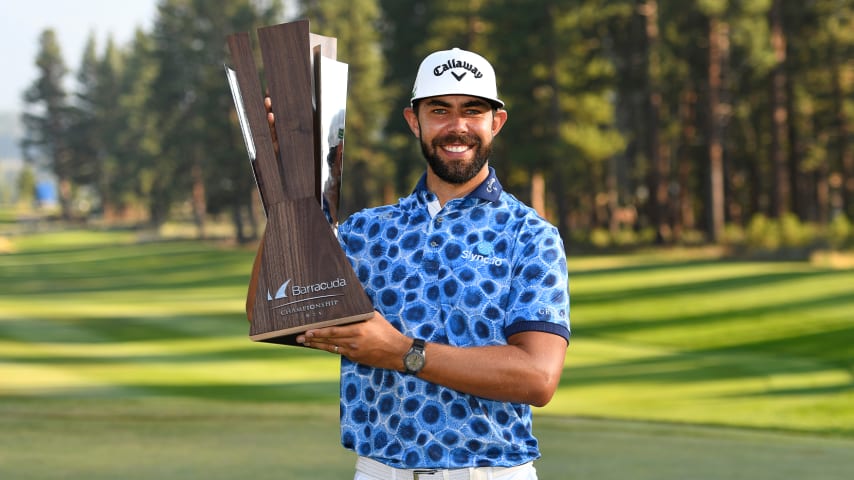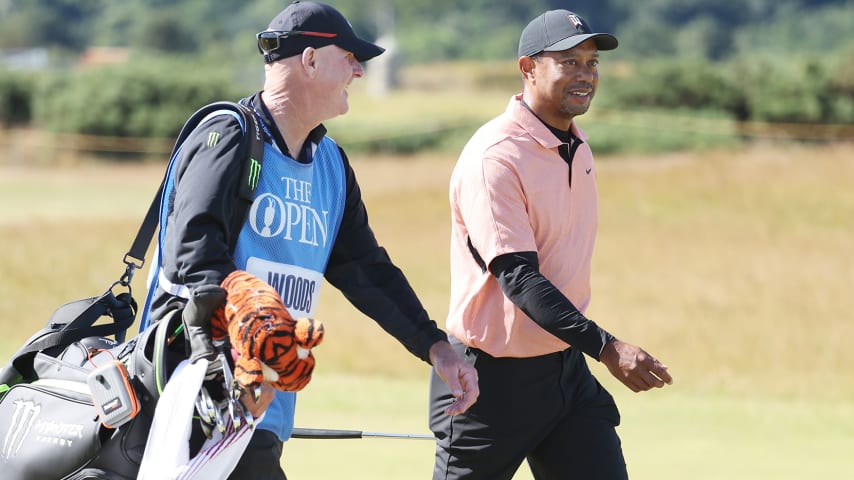How we got to 82
21 Min Read
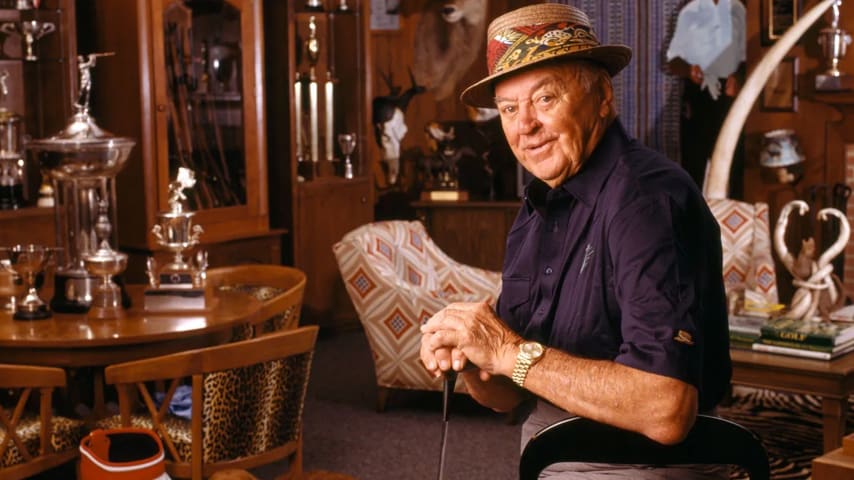
Unlike Tiger Woods’ 81 victories, determining Sam Snead’s official record total of 82 wins required plenty of discussion … and some difficult decisions
Unlike Tiger Woods’ 81 victories, determining Sam Snead’s official record total of 82 wins required plenty of discussion … and some difficult decisions
In his autobiography, “The Education of a Golfer,” Sam Snead recalled a conversation he had one afternoon at Griffith Park, site of the 1937 Los Angeles Open. Snead wrote, “Henry Picard walked up and asked, ‘How are you hitting, Sam? I hear you are bending them halfway to Santa Monica.’”
Snead, who had been struggling with accuracy off the tee, primarily with a hook, wrote of his chat with Picard: “I’m so wild I’ve about decided to quit the tour and go home.” Snead then recounted that he hit some drives to show Picard what he meant. The two pros talked about the positioning of Snead’s feet, and then Picard asked to look at Snead’s driver and said, “This stick is too whippy for you. Your hands are too fast for such a light and swingy club. I’ve got an Izett driver in my car that might be the answer for you.”
Picard returned with the George Izett persimmon model. Snead liked what he saw (and felt) and the two made a little transaction – Picard charged Snead $5.50 – and a week later, with the hook under control, Snead won his first big tournament, the Oakland Open, using the stiff-shafted, 14 1/2-ounce club.
Long after his retirement, Snead reserved a special place for that driver in his Hot Springs, Virginia, home. He never lost sight of how important the club was to him, estimating that three-fourths of all his victories -- official and otherwise -- came with that driver in his bag. Snead would occasionally bring the club out and show it to friends, and he always treated it with reverence.
Said Jack Snead, Sam’s oldest son, “That old driver, that’s what meant the most to Dad. That driver meant more to dad than all the other stuff -- the trophies, the medals -- put together. It meant everything.”
Well, almost everything.
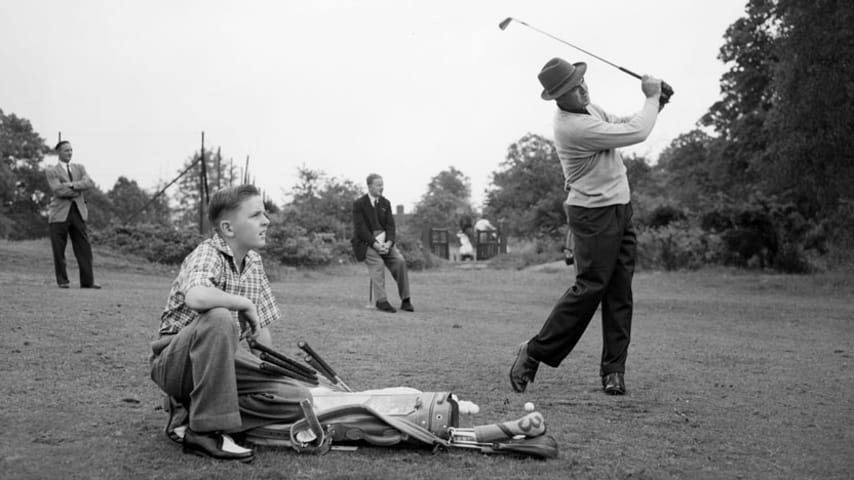
At some point early in Sam Snead’s career, when the Virginia native started winning and winning and winning golf tournaments, the PGA of America, the ruling body for professional golfers in the United States until 1968 when the touring pros broke away and established the PGA TOUR, sat down with Snead and went over his list of victories. The PGA then compiled Snead’s resume.
In the “Official PGA Tournament Record Book,”Snead’s first official victory is listed as the “Virginia Closed Pro, 1936.” In later editions, that tournament had various names, the “Virginia Closed Professional,” the “West Virginia PGA” and finally the “West Virginia Closed Pro.” Whatever the name, the record always showed that tournament as Snead’s first official win.
But did that tournament actually exist? And if so, what exactly was it?
Those were always questions that lingered at PGA TOUR headquarters since there was so little information about the West Virginia Closed Pro. Snead said the tournament was real but had no trophy to show for his work, and any check Snead would have received for the win had long ago been cashed. Even yellowed newspaper clippings were hard to find. Compounding matters, a restaurant in The Greenbrier in White Sulphur Springs, West Virginia, the course Snead represented for much of his professional career, displays a photo of a young Sam Snead (with no hat!) striding down the fairway with pros Billy Burke and Johnny Farrell. It’s a photo that claims to be from the West Virginia Closed Pro but is actually a shot of Snead playing a Greenbrier exhibition with Burke and Farrell.
So what exactly was the West Virginia Closed Pro?
In 2010, theCharleston Daily Mail ran a piece that unearthed information on that 83-years-ago tournament. A Greenbrier press release, dated July 9, 1936, that Ann Snead, Sam’s daughter-in-law, found in an old scrapbook early in 2013, verified the Daily Mail’s findings. The Greenbrier hosted the tournament simultaneously with the West Virginia Amateur, but the “Closed Pro” nomenclature meant no amateurs could play. Snead shot rounds of 70-61 in the one-day, 36-hole professional tournament, defeating nearby Logan Country Club Head Professional Clem Weichman by 16 strokes. It was certainly an impressive feat. But should that tournament have shown up on Snead’s “official” record? Was it really an admissible TOUR event?
And therein lies the rub. It was a Snead win, of that there is no dispute. But since the entire field consisted of local pros from in and around West Virginia and Virginia, and since none of the stars of the day entered, not even TOUR pros from the area—Bobby Cruickshank, Chandler Harper and Denny Shute—its place in history is somewhat dubious. Should it have been considered official?
Snead insisted it was, and that was enough for the PGA of America to include that tournament as win No. 1 on his resume. It was a victory that started Snead on his way to becoming the TOUR’s all-time winningest player and one of the best to ever walk professional fairways. The PGA TOUR has also always recognized that win, partly because it was Snead’s first win, partly because of the way Snead romanticized it and partly because when the TOUR became its own entity, it merely adopted the PGA’s record book.
If there were a question about the West Virginia Closed Pro, what of Snead’s other wins, the remaining 81 with which the TOUR gives him credit? What’s official? What isn’t?
The record clearly shows what Snead didn’t win, famously finishing second at the U.S. Open four times but never able to complete the career Grand Slam by capturing the title. He added 53 additional TOUR runner-up performances during his career. Accepted and certified are most of his other wins, including his three Masters titles, his three PGA Championships, two Western Open titles, as well as his eight victories in Greensboro and six at the Miami Open.
Most of the tournaments on his list of wins are unassailable. Some are not, a faction believing Snead’s five victories in team events (two with Ralph Guldahl, two with Jim Ferrier and one with Vic Ghezzi) should be removed from consideration. The 1946 World Championship of Golf, a four-man event, held at Tam O’Shanter Country Club outside Chicago, is another victory some would like to discard from Snead’s list because, the dissenters say, four players does not a tournament make, regardless of purse size, which, for the time, was considerable.
While various golf observers wanted to drop Snead’s victory total somewhere into the 70s, Snead always contended his once-and-for-all total should have been 89. That number, however, never made it into The Slammer’s narrative, either.
For many years, the TOUR put Snead’s victory total at 84. Then after a 1987 examination of professional golf history, the PGA TOUR reduced that number to 81 before it finally settled on 82 when the TOUR began recognizing The Open Championship as an official victory for any player who won golf’s oldest tournament, something Snead did in 1946 at St. Andrews.
In all, the PGA TOUR also documents Snead winning an additional 62 tournaments not part of his official total. These include 17 West Virginia Open wins, an LPGA title (the Royal Poinciana Plaza Invitational, played on a par-3 course in Palm Beach, Florida, making him the only male to win an LPGA event) and the Havana Invitational in Cuba.
The TOUR removing certain tournament wins from his record disappointed Snead, a decision he couldn’t understand and never accepted. “They took those wins away from me,” Snead often commented to his son, Jack. Snead, inducted in 1974 as an original member of the World Golf Hall of Fame, took that frustration to the grave. He died in 2002, four days short of his 90th birthday.
With Tiger Woods No. 2 on the TOUR’s all-time wins list with 81 after winning his fifth green jacket Sunday at the Masters, he can now tie Snead with his next victory and pass him with two more to become the new record-holder. Thus, Snead’s 82-win total – and the questions surrounding it – are bound to resurface.
Jack Vardaman, Snead’s friend and attorney, “It’s easy to say for Tiger what was official. It’s much, much harder to say that for Sam’s career,”
In January 1986, the PGA TOUR convened a panel that consisted of journalists and PGA TOUR staffers, and the task for those seven men was to compile data from tournaments between 1934 and 1979, events that in many cases didn’t have complete results. The idea was that the TOUR would unveil a historical statistics project that could then be the foundation of the ranking of all PGA TOUR players, regardless of the era in which they played.
A year later, Deane Beman, PGA TOUR Commissioner at the time, assembled a nine-person panel, and it was the members’ job to address the subject of what tournaments the TOUR would consider official and unofficial from the list of events recognized in the TOUR’s statistical system. The panel consisted of author Al Barkow; Joe Black, past president of the PGA of America; Joe Dey, the first TOUR Commissioner; former TOUR player Jay Hebert; Jack Tuthill, a retired TOUR Tournament Director; and Herbert Warren Wind, a noted golf writer, mainly for The New Yorker. Representing the TOUR were TOUR employees Gary Becka, Cliff Holtzclaw and Steve Rankin.
On a Tuesday afternoon at Augusta National Golf Club prior to the beginning of the 1987 Masters – 10 years before Tiger would win his first major at Augusta National -- these nine men met and spent an afternoon making the determination. The main takeaway from the meeting was that the panel amended the “unofficial tournament” list from the previous group’s determinations and changed the record to include tournaments of “historic significance.” That was key verbiage.
Among the other criteria used in the determination were the purse size and the quality of the field in a particular event, the bulk of which had already been researched. In “The History of the PGA TOUR,” the committee noted that “at the conclusion of the meeting, the panel had reviewed each event previously in the ‘unofficial’ column in our study and made its recommendation of which events on the list were of historic significance.”
In defense of the process – which was admittedly light on time spent – this was no easy assignment and the final decision meant it was impossible to satisfy everybody, even if the panel, as Becka explained, went in with no preconceived ideas and made judgment calls based on the available data. “We had a job to do, and we did it. We did what we thought was right,” Becka explained.
Becka also mentioned that while Snead became something of a cause celeb because of the decision, the work the panel did was not simply a Snead project but rather the TOUR undertaking and determining to the best of its ability what happened throughout its history. The decisions famously affected Snead -- both positively and negatively -- but they also impacted numerous other players.
The verdict, as it related to Snead, stated that the early years of the Bing Crosby Pro-Am (now the AT&T Pebble Beach Pro-Am) would be deemed official because of the “historical significance” clause, thanks to the fact that tournament existed then (and still does). That designation for the Bing Crosby-hosted event actually helped Snead’s record because Snead earned official victories for his 1937, 1938, 1941 and 1950 “Crosbys,” which were previously unrecognized.
Yet even those additions cause heartburn for some today, with the 1937 tournament an 18-hole affair, the ’38 and ’41 tournaments 36-hole events and the 1950 “Crosby” a 54-hole tournament, declared a tie, with Snead, Jack Burke Jr., Smiley Quick and Dave Douglas. All earned official-victory designations because darkness set in on the final day without a winner emerging, and a next-day playoff was out of the question because of the players’ travel requirements.
In addition to the four “Crosby” wins, the committee also bestowed official wins on Snead for his 1952 and 1957 Palm Beach Round Robin titles, already crediting him with Round Robin victories in 1938, 1954 and 1955.
Because of the new standard defined by the panel, though, the committee elected to remove nine tournament titles from Snead’s official-win total, most notably his Greenbrier Invitational victories in 1952, 1953, 1958, 1959 and 1961, the latter two tournaments played at The Greenbrier but renamed the Sam Snead Festival. Also gone from his tally were the 1952 Julius Boros Open, the 1940 Ontario Open, the 1942 Cordoba Open and the 1953 Texas Open, which the record book credited Snead with winning, a tournament actually won by Tony Holguin. That Snead received credit for winning the San Antonio tournament meant the PGA of America and the PGA TOUR essentially perpetuated an error for many years.
The panel noted the purse for the 24-player Julius Boros Open that Snead won didn’t meet the minimum threshold, while the 1940 Ontario Open (in Canada) featured only one regular TOUR player (Snead), with the Cordoba Open in Argentina inviting only two non-South Americans to play, Snead and Jimmy Demaret, with Snead winning by 10 shots. For those reasons, the TOUR dropped the victories and not because they were contested outside the U.S., at one time a popular notion.
So just like that, Snead went from 84 wins to 81. As they might ask in Argentina, ¿Esta contento vos, Sam?
No. No he wasn’t.
Vardaman, the Harvard-educated attorney, often heard Snead talk about his loss of tournament victories during their friendly golf matches in Hot Springs, Virginia, at The Cascades. Sitting in his spacious 11th-floor Williams & Connolly office on 12th Street Northwest in Washington, D.C., a space with an original oil painting of Snead hanging on one of the walls, Vardaman leaned back in his chair and said, “Sam complained forever about the TOUR taking away the tournaments. I think Sam always figured his place in history would be defined by the number of tournaments that he won. It wasn’t going to be for winning 11 in a row, winning 11 tournaments in one year or even a career Grand Slam. There were some things he didn’t do. But he did win more tournaments than anybody else. That was important to him.
“Losing those tournament wins,” Vardaman continued, “always gnawed at him.”
So, on January 25, 1996, a little less than nine years after Snead’s record changed, Vardaman, on Williams & Connolly letterhead, authored an impassioned five-page letter to then-PGA TOUR Commissioner Tim Finchem, essentially laying out Snead’s case. The attorney was in opening-argument form. The letter began:
Dear Commissioner Finchem, I am writing on behalf of Sam Snead to request that you reexamine the PGA Tour’s determination of the number of Sam’s tournament victories. For the reasons stated below, we think the PGA Tour should credit Sam with 89 significant tournament victories.
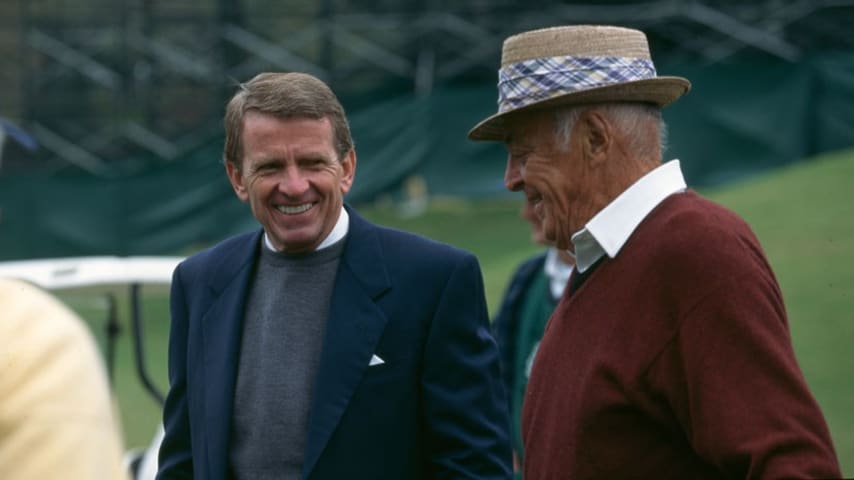
Vardaman, who has argued numerous cases in front of the U.S. Supreme Court during his career, was ready to fight for his golf partner in pro-bono fashion. And Vardaman wasn’t just some attorney trying to right an injustice for his client. Vardaman was the former general counsel of the United States Golf Association, an accomplished amateur golfer in his own right who had won his fair share of tournaments and is a member of four golf clubs.
Vardaman, like his client, felt the TOUR had erred, with the Greenbrier Invitational/Sam Snead Festival omissions his main point of contention.
“My view is that if it was viewed as official at the time by the ruling body of golf, the subsequent ruling body shouldn’t go back and declare it unofficial,” Vardaman explained. “It’s a little bit presumptuous of the TOUR to say, ‘We’re going to go back and determine what was official and what wasn’t official, what was important and what wasn’t important, when somebody else ran the whole Tour.
“It’s like if somebody went back and said some of Babe Ruth’s home runs were in a different field and the field wasn’t up to Major League specs so we should take those away,” Vardaman added.
Ironically, despite the frustration Snead felt about his loss of wins, the 1987 statistical analysis led to this:
The TOUR determined that in three different, meaningful statistical categories that took into consideration 1) the Ryder Cup points system used in the 1980s, 2) tournament performance based on the percent of a tournament’s total purse, and 3) a lifetime points-based system constructed to reflect career top-25 finishes, Snead came out on top in all three metrics.
Translation: He was the TOUR’s best player.
That gave Snead some ammo, and he did revel to the late Dave Anderson of the New York Times after the release of the data, noting that he finished ahead of No. 2 on the TOUR’s list, Jack Nicklaus, who won his 73rd and final TOUR event at the 1986 Masters. “Jack’s where he should be. Second. I like that,” Snead said to Anderson.
Maybe that bit of notoriety was something of a soothing balm to Snead, however it didn’t take away the sting of losing those tournament titles.
As Vardman reiterated, the PGA of America never recognized those Greenbrier Invitational/Sam Snead Festivals because they either didn’t offer the minimum-accepted-purse amount, were played opposite officially sanctioned events -- or both. His contention, naturally, was that it should have.
For instance, The Greenbrier, an elegant, small-town hotel and resort in White Sulphur Springs, held the 1959 Sam Snead Festival at its course opposite the PGA’s Arlington Hotel Open, hosted by an elegant, small-town hotel and resort in Hot Springs, Arkansas. While Snead won his eponymous 1959 Festival by 11 strokes over Mike Souchak in a field that also included E.J. “Dutch” Harrison, Bruce Crampton, Doug Sanders, Jim Turnesa and Gary Player, it was Gene Littler who was beating Jim Ferree in Arkansas by a stroke, with Doug Ford, Tommy Bolt, Cary Middlecoff and Tony Lema among the 99 players entered.
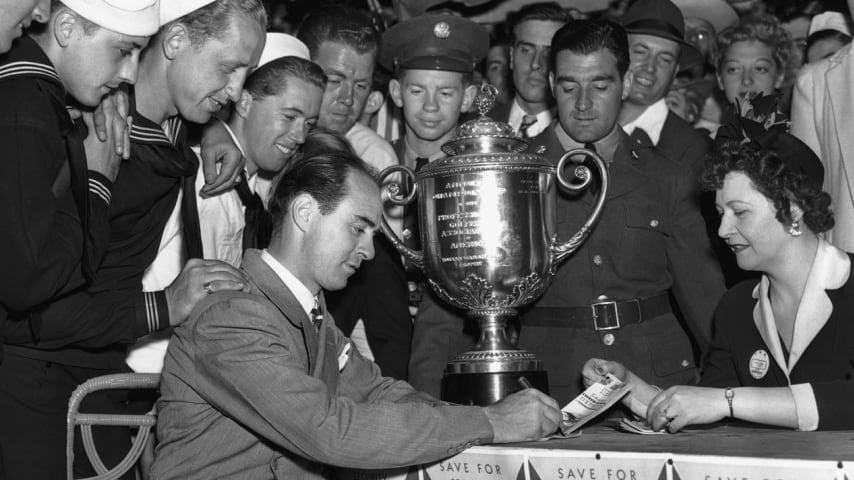
Two years later, Snead defeated Canadian Stan Leonard by a stroke at the Festival while holding off Player, Arnold Palmer and Peter Thomson. Approximately 860 miles away, the PGA was conducting the newly named Hot Springs Open, and Sanders was beating the likes of Middlecoff, Boros, Al Geiberger and Tommy Aaron. Such was the nature of professional golf back then, two tournaments of equal stature played simultaneously, the organizers hustling to attract the best players to their events. Only one tournament, though, part of the official schedule.
“The designation of something as official, like Arkansas, as opposed to the other, Greenbrier, which had more stars, well it makes no sense. Which is more historically significant, the one that had the best players or the one that was considered ‘official?’ That seems to me to be exactly what the panel was saying they were not going to do,” Vardaman reasoned.
He was just getting started.
“Sam won a lot of tournaments. Tiger has won a lot of tournaments. But due to the lack of accepted criteria given the change between the PGA of America and the PGA TOUR, the different ruling bodies of golf, it just seems wrong to me to start taking things away from somebody.”
Beman, who spearheaded the effort to clean up the TOUR’s record books and classify tournaments before retiring in 1994, said, “Some judgments had to be made, and I think they were the right judgments.”
Finchem, who received the 1996 letter from Vardaman, had his staff again examine the record and chose not to make any of the changes Vardaman requested. “It’s always difficult to compare different generations, whether it’s tournaments or players,” Finchem said. “With the data we had, we did what we thought was fair and reasoned, understanding how different professional golf has been over the years.”
To Finchem’s point, Snead played when match play and four-ball team events were common, where tournaments didn’t necessarily start on Thursday and end on Sunday and 36-hole finishes on the final day and 18-hole playoffs were not unusual.
Simple feuds also factored in, and that brings up the question of the 1949 North and South Open, a significant event that began the same year the PGA of America opened up shop – 1916 -- and ran through 1951 (World War II interrupted the 1943 event), with all the tournaments played at Pinehurst’s famed No. 2 Course.
However, in 1947, 1948 and 1949, the PGA didn’t recognize the North and South as official. Back then, the Tufts family, the owners of Pinehurst, as the story goes, had a dispute with the PGA of America about money. While the North and South went on during those three years as usual, the PGA didn’t acknowledge its existence on the official schedule. That’s important because in Snead’s PGA TOUR official record, his 1949 North and South victory doesn’t count. His 1941 and 1950 North and South wins do.
“Again, one of the criteria we used in determining if an event was official was whether or not it appeared on the official schedule that year. Those three years of the North and South weren’t on the schedule, so we accepted that and didn’t count them,” Finchem explained. “That decision by us didn’t just affect Sam’s victory record but Jim Turnesa’s (1947) and Toney Penna’s (1948), as well.”
During his PGA TOUR Champions years, starting in the late 1970s, Snead became close friends with former Golf Digest editor Don Wade after Wade wrote a magazine story on The Slammer. For each subsequent Snead piece Golf Digest ran, Wade was the writer, and the two men knew each other well.
“Sam never said much publicly about his loss of tournament wins,” said Wade, who died in 2014. “But I do know his feeling was that he beat the best players who were out there, and he felt it was an arbitrary decision by the TOUR on getting to the final number (of wins).
“Sam, like all of the guys back then, had tremendous pride in what he accomplished. He was proud of his wins, and that decision to reduce the number was hard for him to take.”
For a while it seemed a fait accompli that Woods would eventually catch and pass Snead on the all-time victory list, maybe as soon as 2014 after he won five titles in 2013. Injuries and other issues kept Woods winless between his final win of 2013, the World Golf Championships-Bridgestone Invitational, until he broke through at the season-ending TOUR Championship last fall. After he secured win No. 80, in Atlanta, it took him just six starts in the 2018-19 PGA TOUR season before claiming No. 81.
Five years ago, Jack Snead readily admitted that Tiger would slip past his father on the all-time list.
“First and foremost, both are terrific champions, two of the best the game has ever seen. Rather than compare the two eras, I like to think of both Sam and Tiger as great players and recognize all they have meant to both the PGA TOUR and golf in general,” said PGA TOUR Commissioner Jay Monahan, who succeeded Finchem in 2017.
Monahan also agrees with Finchem, knowing comparing eras is far from scientific.
“The PGA TOUR today is vastly different from the PGA TOUR of Sam’s era, especially in those early years when we sometimes played 36 holes in one day, players traveled from tournament to tournament by car and the equipment players used and course conditions were not what they are today,” Monahan rightly noted. “Compared to the way TOUR events are currently operated, our tournament structures differed significantly during the prime of Sam’s career, as well. With all that in mind, it’s challenging to evaluate players’ careers coming from two separate eras of our history. I know my predecessors care deeply about the game and were guardians of PGA TOUR golf. I am confident they made the best possible decisions based on available information, and I trust their judgment.”
Snead passed away 17 years ago. Very few of his player contemporaries remain, and one by one his close friends have passed. One of those was West Virginia native Bill Campbell, who admitted four months before his death in 2013 that Sam’s spot on the top of the winner’s chart was likely coming to an end. His comments, however, came before Tiger’s five-year winless drought began.
“There was always a lot of argument about how many wins Sam had, whether it was 81 or 82 or whatever the number was. He fussed around about that, and I’m not in a position to say what the number should have been one way or the other,” said Campbell, the legendary career amateur and USGA and Royal and Ancient administrator who first met Snead when Campbell was 14 and he attended, with his dad, the 1937 West Virginia Open at Guyan Country Club. A year later, Snead asked Campbell to play with him in a pro-am at The Greenbrier.
“By then I was a pretty good junior player and playing with Sam was something. This was my first experience with the great man.”
Added Campbell after a short pause, “This much I know: Sam was a great winner.”
But was Snead the greatest? For now, the record book says he is, and only one other player is close enough now to say whether that will continue.




